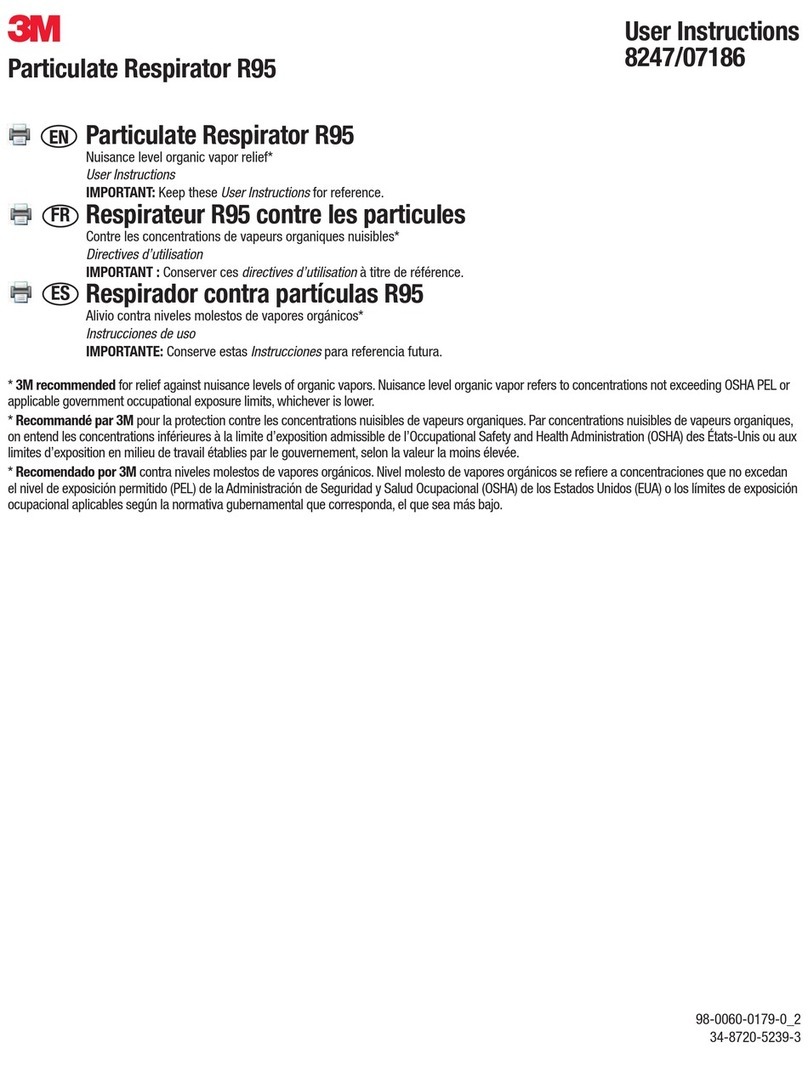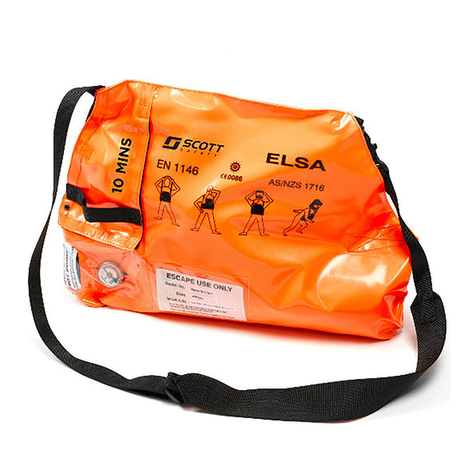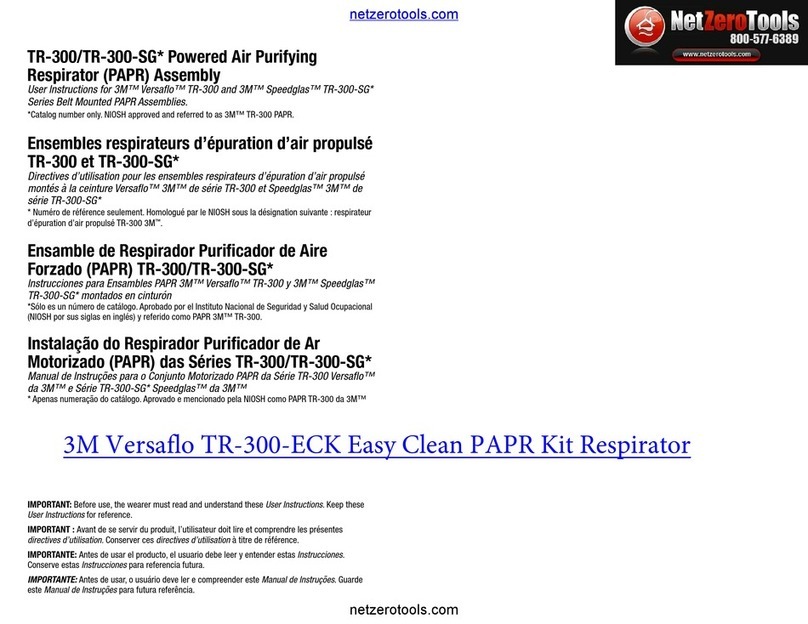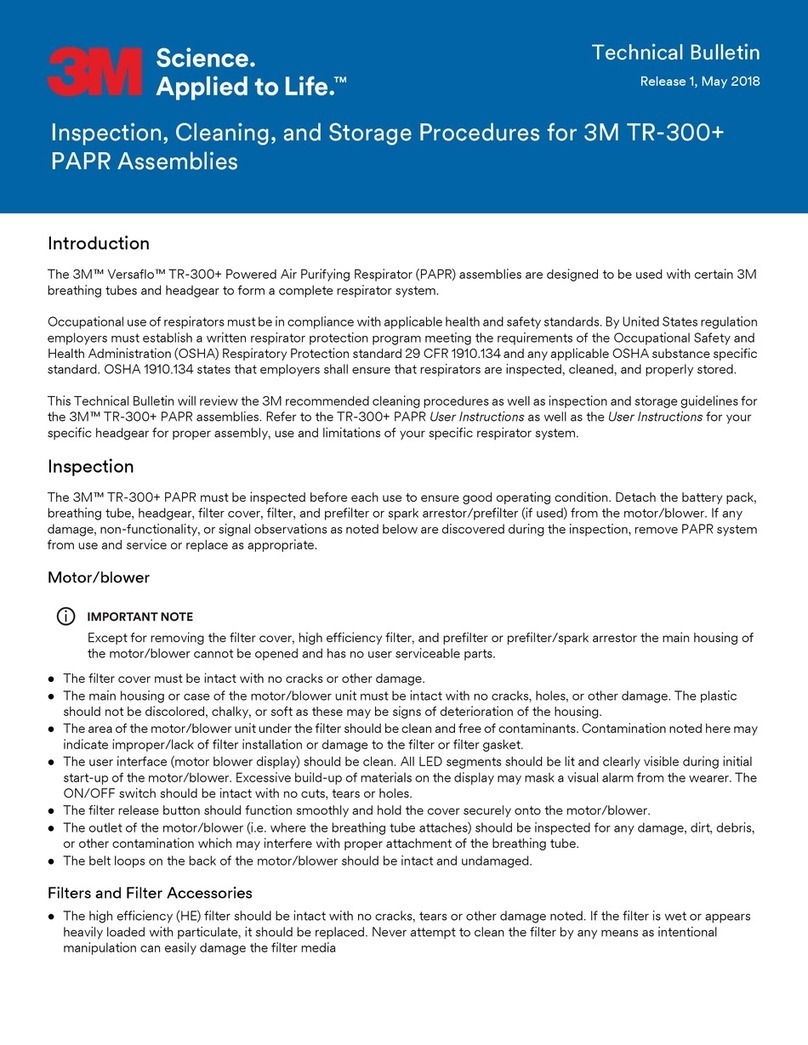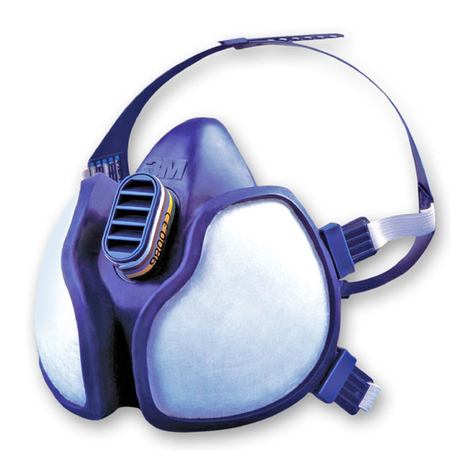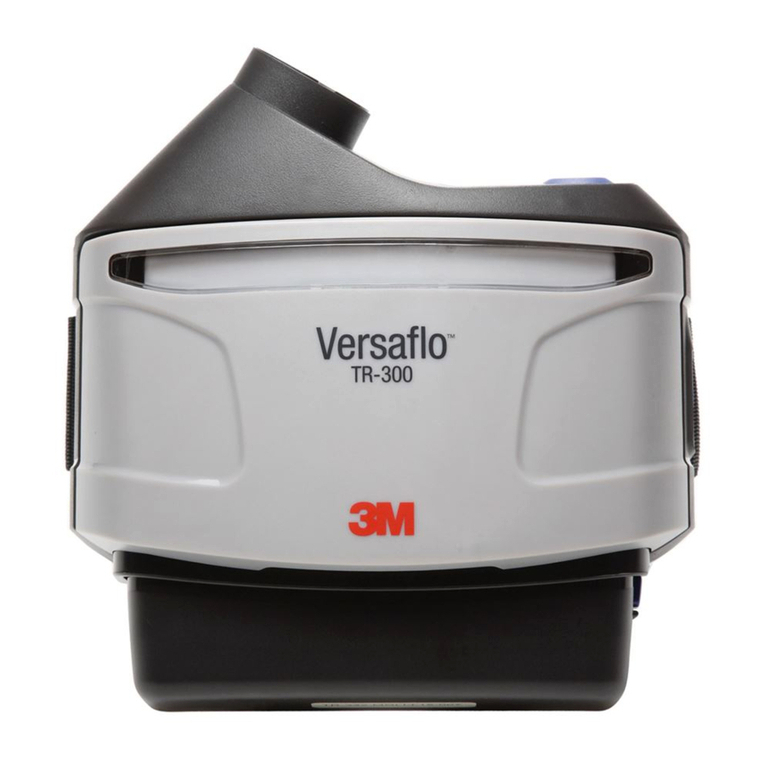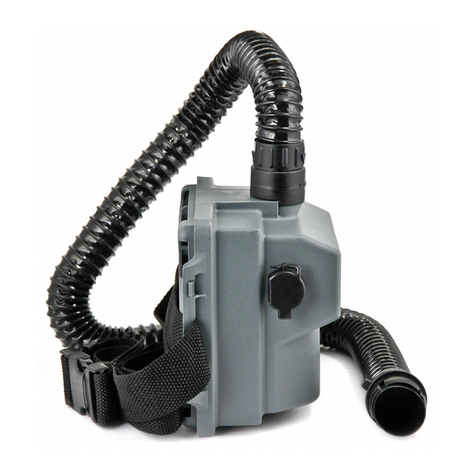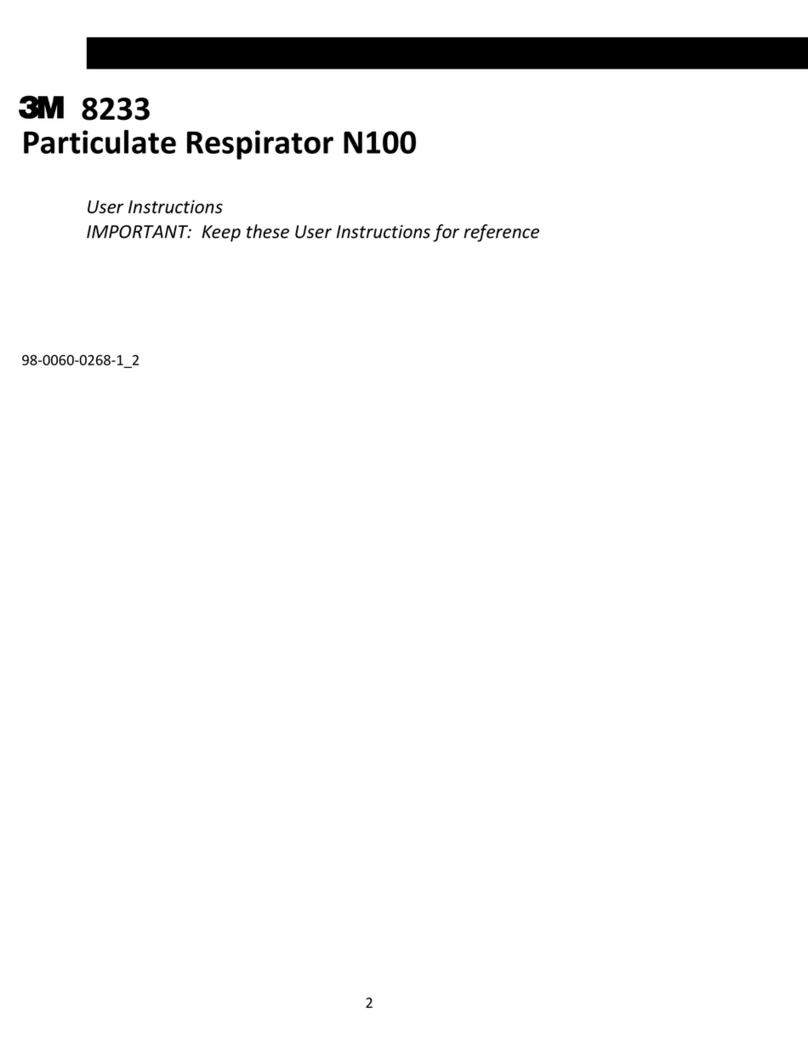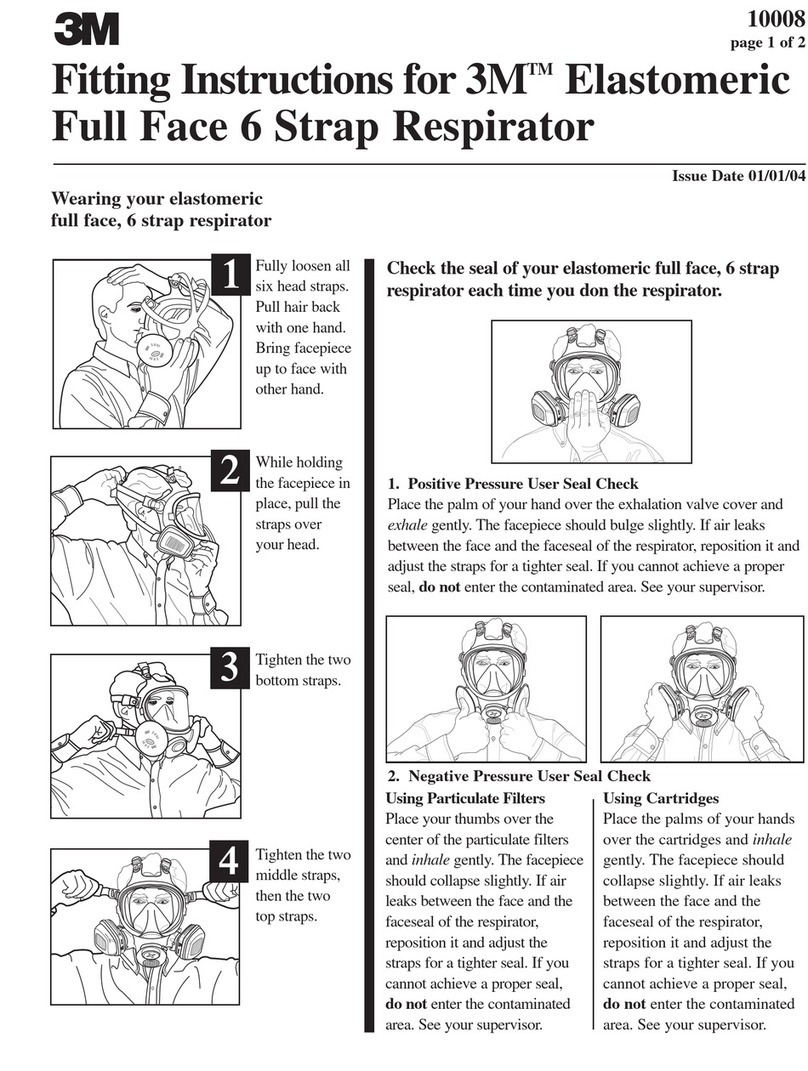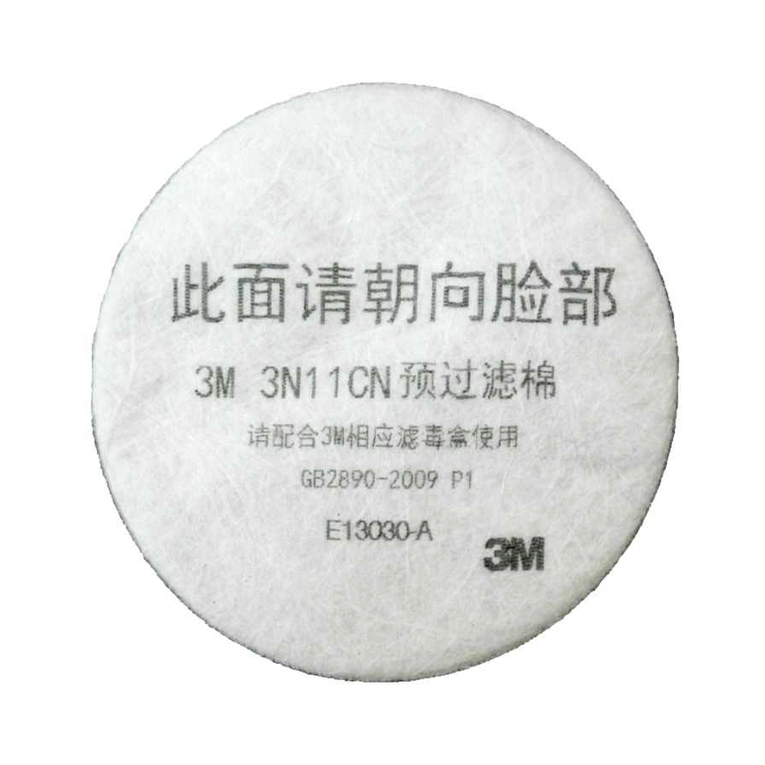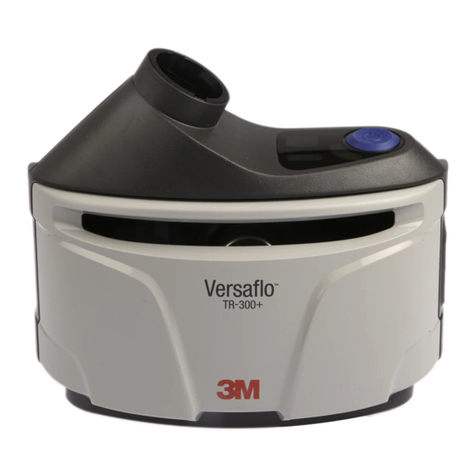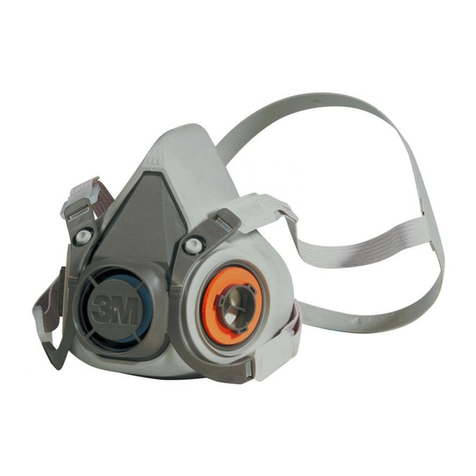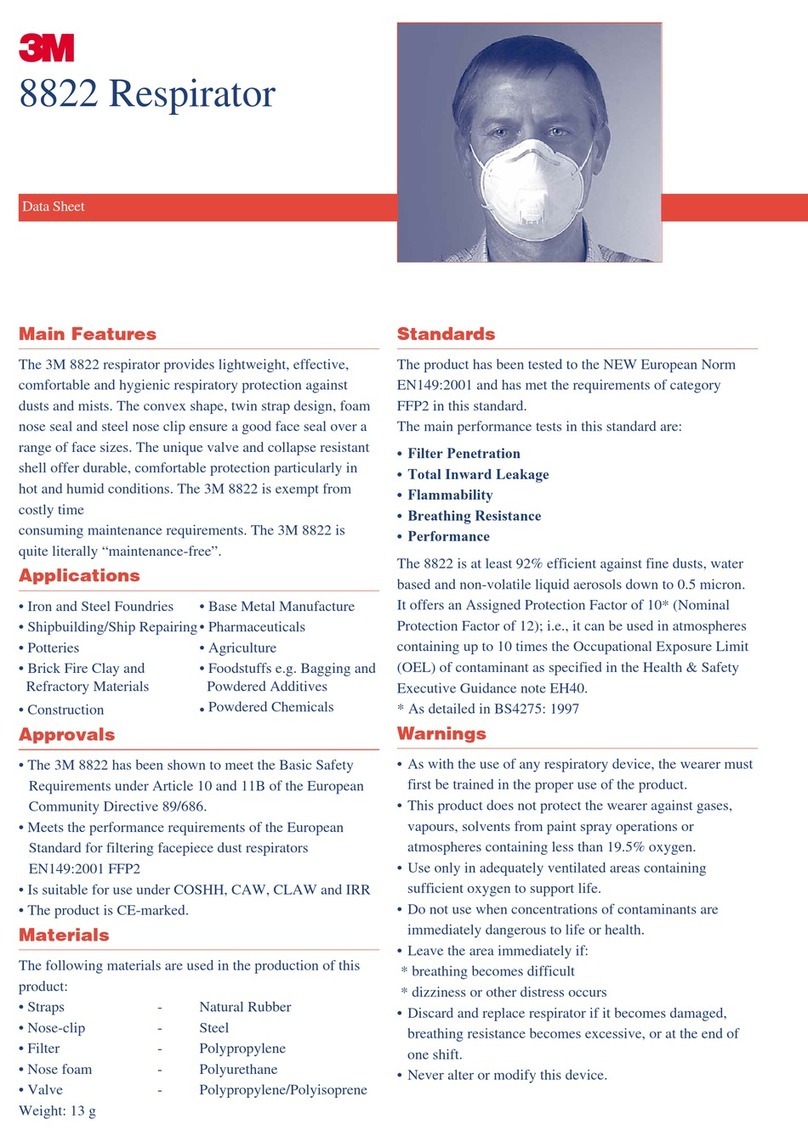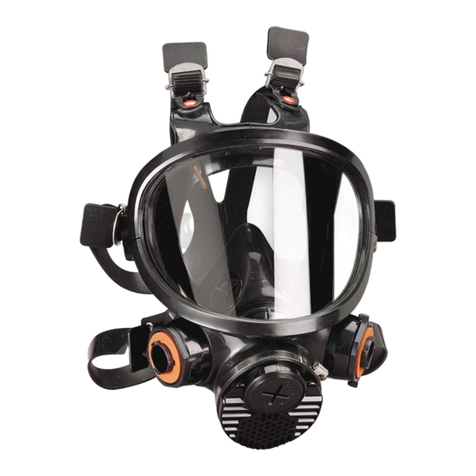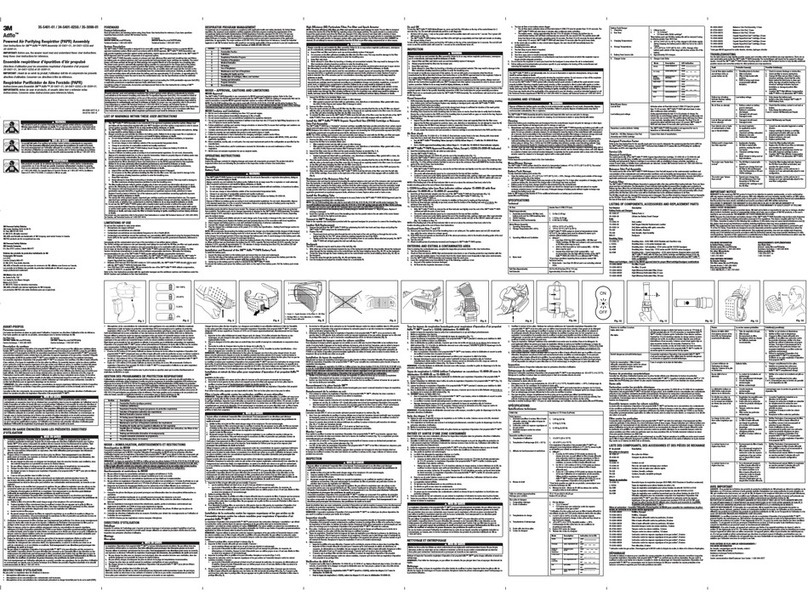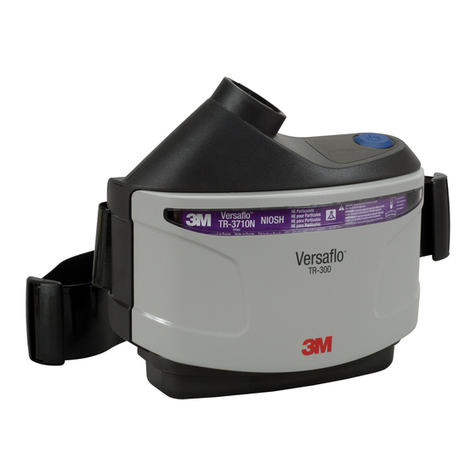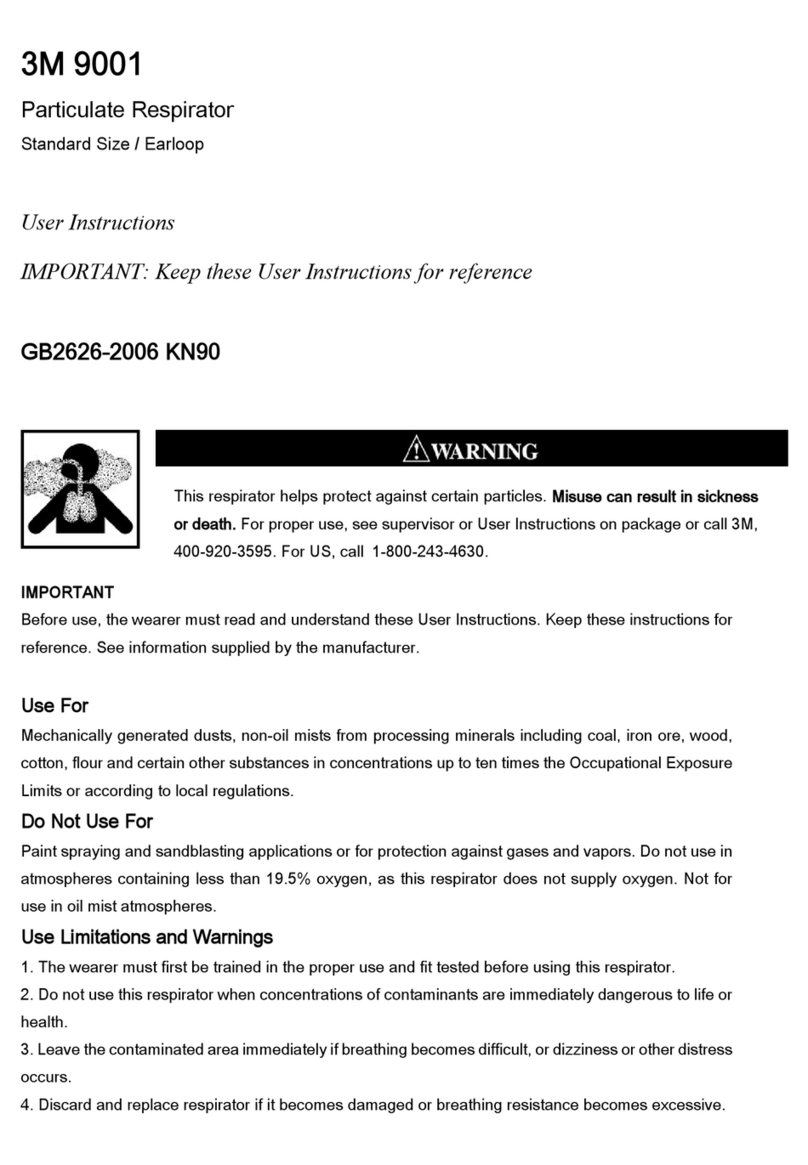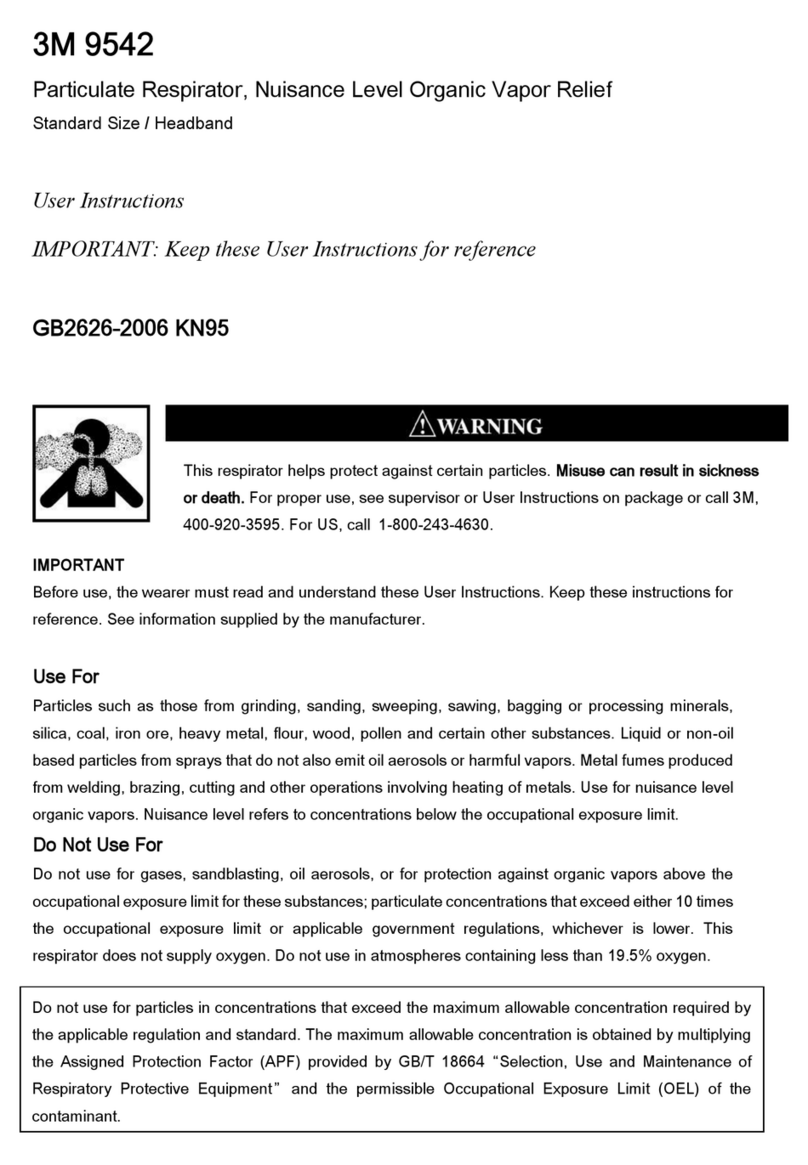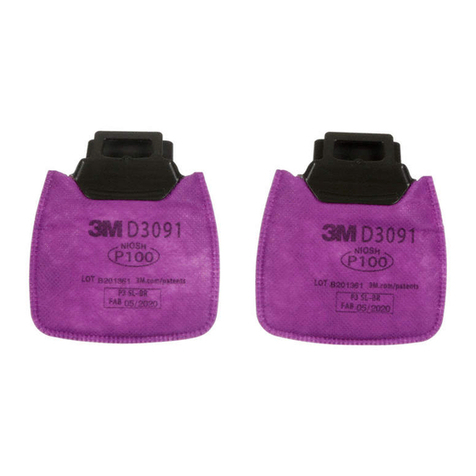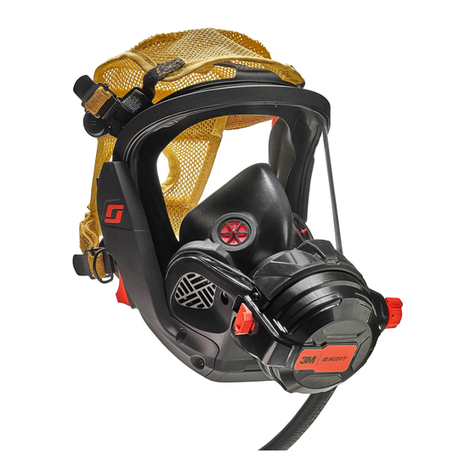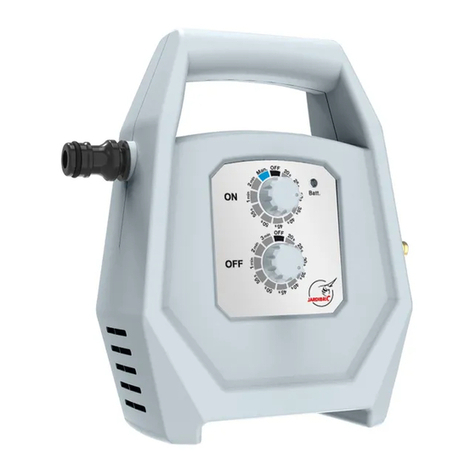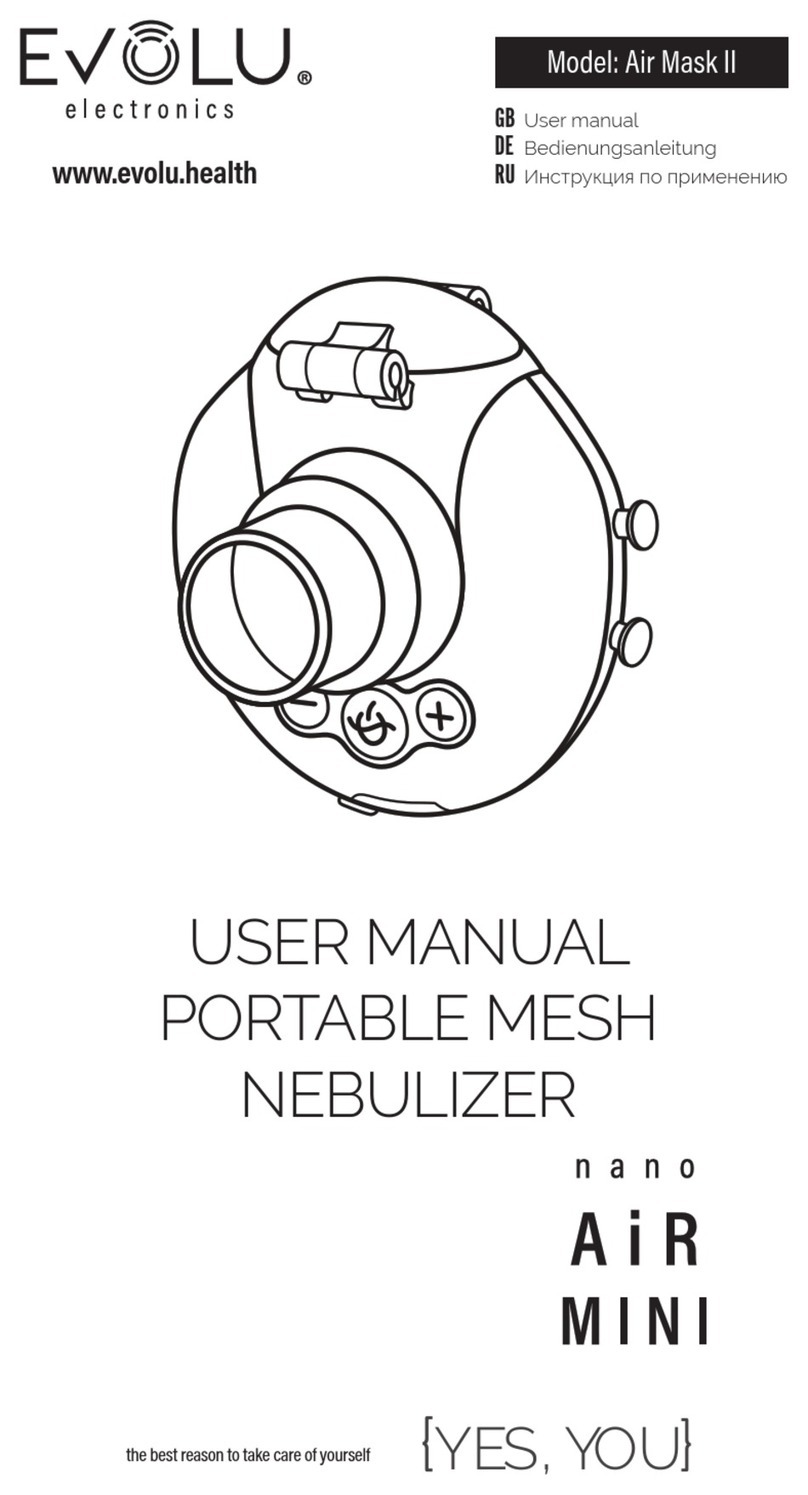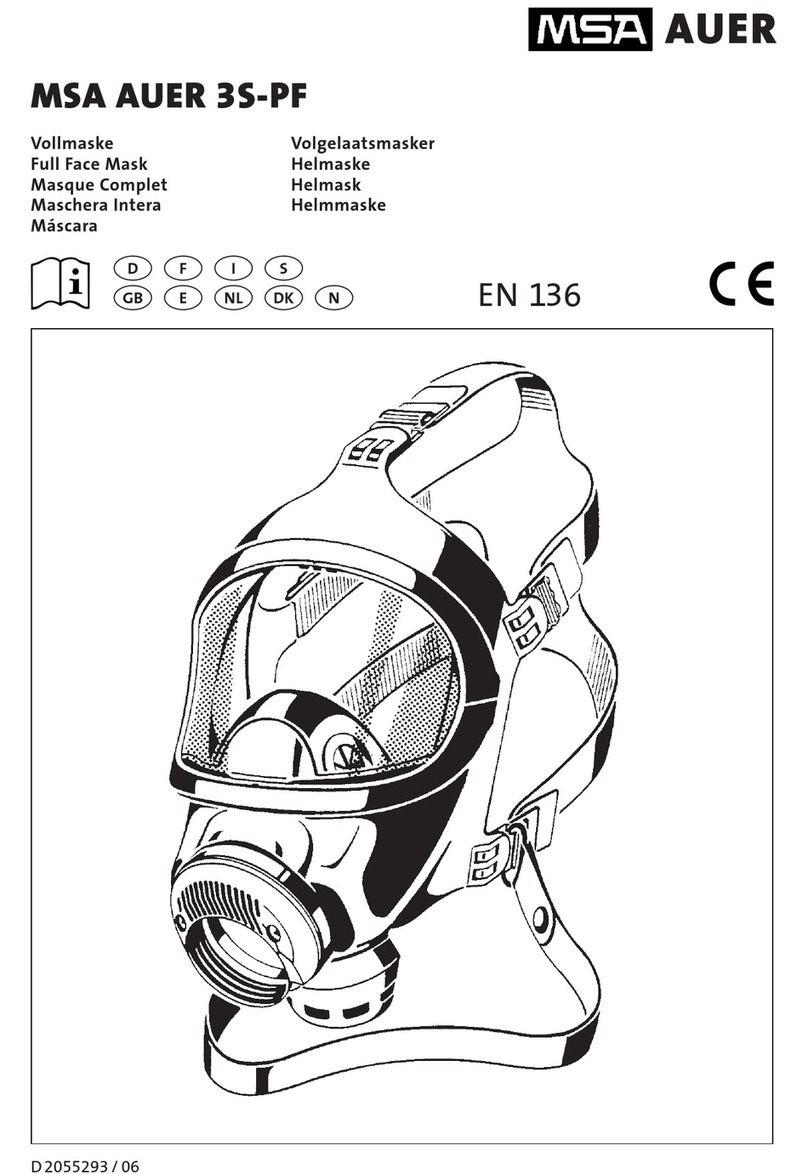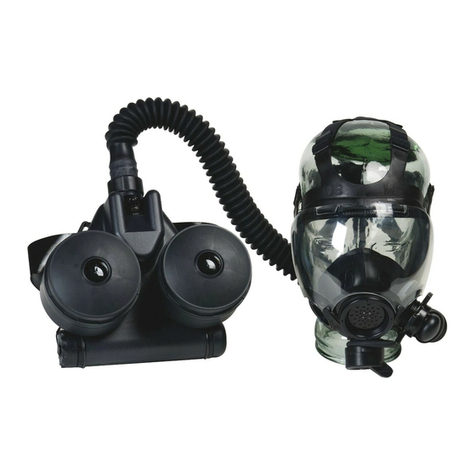
Assembly
3M™ Cartridge 6000 Series, Filter 7093, and Cartridge/Filter 7093C Assembly (Fig. 1, 2)
1. Align the cartridge or lter notch with the small solid bayonet lug on facepiece and push together.
2. Turn cartridge or lter clockwise until it is rmly seated and cannot be further turned (about 1/4 turn).
3. Repeat with second cartridge or lter.
3M™ Filter 2000 Series (Fig. 3)
1. Align opening of lter with lter attachment on facepiece and push together.
2. Turn lter clockwise until it is rmly seated and cannot be further turned.
3. Repeat for second lter.
Filter Assembly (for 3M™ Filters 5N11 and 5P71)
1. Place lter into 3M™ Retainer 501 so printed side of lter faces the cartridge.
2. Press cartridge into lter retainer.It should snap securely into lter retainer.When correctly installed, lter should
completely cover face of cartridge (Fig. 4).
3. To replace lter, remove retainer by lifting on tab.
In Brazil, the 3M™ Filter 5935BR can be used with the 3M™ Filter Retainer 501 on the 3M™ Full Facepiece FF-400
Series.
3M™ Adapter Assembly 502
1. Align adapter over cartridge. Engage front snap by squeezing front of cartridge and adapter together,placing
thumbs of both hands over top of adapter and ngers along bottom sides of cartridge (Fig. 5).
2. Engage back snap by squeezing back side of cartridge and adapter together using the same hand positions. An
audible click should be heard as each snap is engaged (Fig. 6).
3. Place lter onto the lter holder so that lter comes into even contact with gasket. Twist clockwise a quarter turn
until it is rmly seated and lter cannot be turned further.Repeat for second lter.
IMPORTANT: The 3M™ Adapter Assembly 502, once installed on a 3M™ Cartridge 6000 Series,is not to be
removed or reused. Removal or reuse may result in leakage, overexposure,sickness or death.
3M™ Filter Adapter 603 Assembly and Filter Attachment (for 3M™ Filters 5N11 and
5P71)
1. Align notch on edge of 603 adapter with facepiece mark as shown (Fig. 7).
2. Turn adapter 1/4 turn clockwise to stop. To remove adapter,turn 1/4 turn counterclockwise (Fig. 8).
3. Place lter into 501 retainer with lter printing facing towards the 603 adapter. Snap together and ensure the lter
seal is free from creases or gaps (Fig. 9).
In Brazil, the 3M™ Filter 5935BR can be used with the FilterAdaptor 603 and the Filter Retainer 501 on the 3M™ Full
Facepiece, FF-400 Series.
3M™ Dual Airline Respirator Assembly
User must follow Dual Airline Supplied Air Respirator User Instructions provided with the 3M™ Dual Airline Supplied Air
Respirators.
Assembly of Dual Airline Breathing Tubes
1. Hold the facepiece in front of you so that the 3M logo is facing you. Align the two branches of the breathing tube
over the two bayonet mounts on facepiece (Fig. 10).For 3M™ Breathing Tubes SA-1500 or SA-1600, make sure
that 3M logo on breathing tube and on facepiece are both facing towards you. For 3M™ Breathing Tubes SA-2500
or SA-2600, make sure that the 3M logo on breathing tube is facing in opposite direction to 3M logo on facepiece.
2. Twist each branch of breathing tube clockwise a quarter turn until it is rmly seated in the bayonet and cannot
be turned further (Fig. 11 and 12).Do not forcibly overturn as the bayonet could be damaged. SA-1500/SA-2500
shown.
3. Attach airline to approved air regulators per pressure schedules in dual airline, supplied air respirators User
Instructions.
Assembly of 3M™ Combination Dual Airline Breathing Tubes with Cartridges and/or
Filters
The SA-1600 (front-mounted) and SA-2600 (back-mounted) versions of the 3M™ Dual Airline Breathing Tubes allow
use of selected, NIOSH-approved 3M™ Cartridge 6000 Series and 3M™ Filter 2000 Series. For the listing of approved
cartridges and lters, reference the NIOSH approval label included with 3M™ Dual AirlineAdapter kits.
1. Attach SA-1600 or SA-2600 breathing tubes to facepiece per the procedures outlined previously.The procedure is
identical to the SA-1500 and SA-2500 models.
2. Make a selection of cartridges and/or lters that meets your respiratory protection requirements, and attach to the
outer bayonets of SA-1600 or SA-2600 breathing tubes.
3. Don facepiece per procedures outlined in Donning Respirator section of instructions.
4. After being properly t tested, perform a positive and negative pressure user seal check each time the respirator is
donned per procedures outlined in User Seal Check section of instructions.
If you cannot achieve a proper t, DO NOT enter contaminated area.See your supervisor.
To assemble 3M™ DualAirline Combination Breathing Tubes with 3M™ Cartridges/Filters, the facepiece inhalation
valves must be removed.
IMPORTANT: If the facepiece is to be used in air-purifying mode (without using the SA-1600 or SA-2600 breathing
tubes), the inhalation valves must be replaced in the facepiece before use.
Using the 3M™ Combination Dual Airline Breathing Tubes without Cartridges
and/or Filters
To use the 3M™ Combination DualAirline Breathing Tubes (SA-1600 and SA-2600) without cartridges or lters, attach a
3M™ Bayonet Cap 6880 to each outer bayonet mount on the dual airline breathing tube. When used as a straight,Type
C, continuous ow supplied air respirator, the Assigned Protection Factor is 1000 times the PEL,OEL or TLV guidelines
for full facepiece respirators.
FITTING INSTRUCTIONS
WWARNING
Failure to follow these instructions may reduce respirator performance, expose you to contaminants
above the OEL, and may result in sickness or death.
• To help maintain a good seal between the face and the faceseal,the respirator faceseal must
be clear of obstructions at all times. Do not use with beards or facial hair that prevent direct
contact between the face and the respirator faceseal. Do not use with corrective eyeglasses. If
corrective eyeglasses are required, a 3M™ Spectacle Kit must be used inside the respirator.
These instructions MUST be followed each time respirator is worn.
Donning Respirator
NOTE: Two key factors in effective donning are placing the nose in the nose cup initially to center the respirator
on the face and to tighten the straps twice following steps 4, 5,6, rst to snug the respirator then repeating
steps 4, 5, 6 a second time to secure the facepiece seal. Care must be taken to not over tighten bottom straps
on the rst turn.
1. Fully loosen all six headstraps.
2. Hold the front of the facepiece with one hand and the straps/comfort cradle away from the facepiece with the other
hand, creating an opening for the head. Pull the respirator assembly down over the head and face through the
opening. Place the nose in the nose cup and chin in the chin cup area then press the facepiece rmly and evenly
against the face (Fig. 13).
3. Pull head harness to back of head (Fig. 13).
NOTE: Repeat the sequence of steps 4-6 twice, once to snug the straps and take up slack and a second time to secure
and seal the respirator facepiece to the face.
4. Tighten the bottom straps one at a time. Be careful to tighten both sides equally (Fig. 14).
5. Tighten the middle straps one at a time. Be careful to tighten both sides equally.
6. Tighten the top straps one at a time. Be careful to tighten both sides equally.
7. Recheck all straps to ensure that they are tight and evenly tensioned so that the head harness is centered on the
back of your head. Ensure that the straps and tabs lay at against your head.
If possible, have a partner verify that you have donned your respirator properly. Perform a user seal check as described
below.
Initial Selection of Small, Medium or Large Facepieces
More than one facepiece size may need to be donned before you determine the best size for your face.
After donning verify the following.
1. Nothing (e.g. hair, jewelry,etc.) comes between the face and the sealing surface of the respirator.Facial hair or
sideburns may have to be trimmed.
2. Bottom straps and middle straps do not cut into ears.
3. Eyes are looking between center and top 1/3 of the lens.
4. Respirator does not press so tightly against face that eyes are partly closed.
5. Bottom of the mask assembly does not cut into throat.
6. No visible gaps between the face seal and the face.
7. Skin in front of ear is not wrinkled.
8. Nosecup does not obscure vision.
9. Ensure that other safety equipment does not interfere with buckles or t of respirator.
If any of these criteria are not met, it is possible that the respirator may not t you adequately. Selecting a different
size facepiece may provide you with a more adequate t. More than one facepiece size may need to be donned before
you determine the best size for your face. A t test can conrm adequate t.If you have further questions, see your
supervisor.
User Seal Checks
Always check the seal of the respirator on your face before entering a contaminated area according to the
instructions provided below for your specic respirator conguration. The positive pressure seal check is the primary
and preferred method for verication of a good seal for all cartridge and lter congurations. The positive pressure seal
check is the only method for this respirator with Filters 2000 Series. The negative pressure user seal check can also be
done for additional verication of a good seal for this respirator with Cartridges 6000 Series and Filters 7093/7093C. Be
careful not to disturb the respirator seal by pressing too forcefully during negative pressure seal checks.
IMPORTANT: If you cannot achieve a proper seal, DO NOT enter the contaminated area. See your supervisor.
Before assigning any respirator to be worn in a contaminated area, a qualitative or quantitative t test MUST
be performed per OSHA Standard 1910.134, CSA Standard Z94.4 or Brazil Respiratory Protection Program of the
Ministry of Labor.
Positive Pressure User Seal Check for all approved congurations and required for
Filters 2000 Series
1.
2.
3.
Remove the exhalation valve cover by depressing bottom of cover with thumb and sliding cover up, parallel with
lens.
Place the palm of your hand over the exhalation valve and exhale gently (Fig. 15). Care must be taken to ensure a
good seal of the exhalation valve. To do this, cover the entire face of the blue valve with the base of the palm.
If the facepiece bulges slightly and no air leaks are detected between the face and the facepiece, a proper seal has
been obtained.
4. If faceseal air leakage is detected, reposition the respirator on your face and/or readjust the tension of the straps to
eliminate leakage and recheck seal.
5. Replace exhalation valve cover by placing open end at top of exhalation valve assembly, guide tabs underneath
valve cover assembly and slide downward until the valve cover snaps in place.
If faceseal air leakage is detected, reposition the respirator on your face and/or readjust the tension of the straps to
eliminate the leakage and recheck seal. Care must be taken when performing the positive pressure seal check not to
exhale too hard. The aim is to check the seal,not disturb the seal between the mask and the face.
Negative Pressure User Seal Check with Cartridges 6000 Series
1. Place palms of hands to cover face of cartridge or open area of 3M™ Filter Retainer 501and inhale gently.If you
feel the facepiece collapse slightly and pull closer to your face with no leaks between the face and facepiece, a
proper seal has been obtained (Fig. 16).
2. If faceseal air leakage is detected, reposition the respirator on your face and/or readjust the tension of the straps to
eliminate leakage and recheck seal.
Be careful not to disturb the respirator seal by pressing too forcefully during negative pressure seal checks.
NOTE: Use of lter retainer 501 may aid respirator wearer in conducting a negative pressure user seal check.
Negative Pressure User Seal Check with Filters 7093/7093C
1. Using hands squeeze or press lter covers toward facepiece and inhale gently. If you feel the facepiece collapse
slightly and pull closer to your face with no leaks between the face and facepiece a proper seal has been obtained
(Fig. 17).
2. If faceseal air leakage is detected, reposition the respirator on your face and/or readjust the tension of the straps to
eliminate the leakage and recheck seal.
Be careful not to disturb the respirator seal by pressing too forcefully during negative pressure seal checks.
